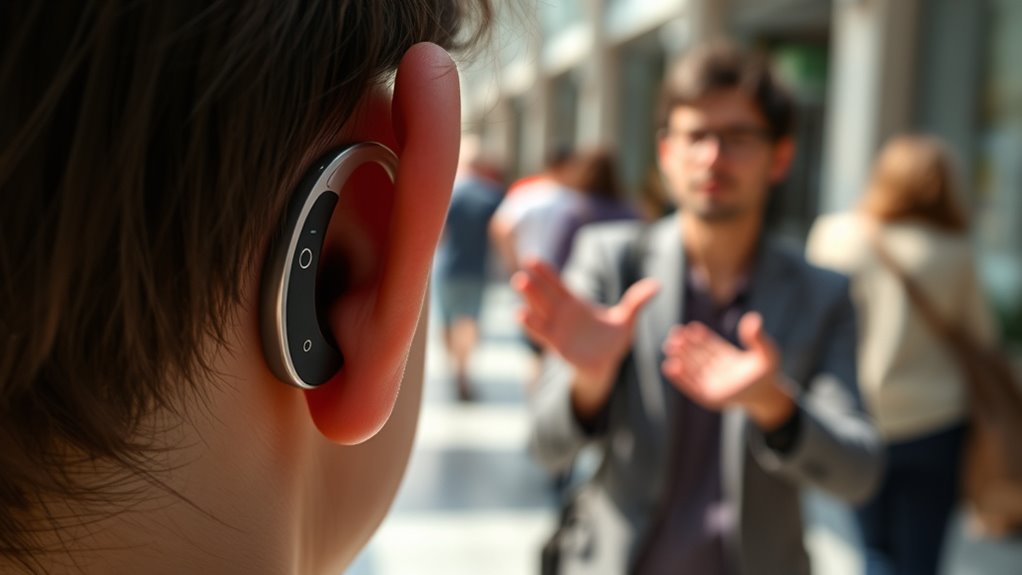Smart hearing aids now feature technology that can automatically translate sign language into speech in real time, making communication more natural and inclusive. They use advanced sensors and algorithms to instantly interpret gestures, filter out background noise, and produce clear spoken words. This seamless process allows you to participate effortlessly in conversations without manual adjustments or extra gadgets. As this technology continues to evolve, you’ll discover even more ways it can transform your interaction experiences.
Key Takeaways
- Advanced hearing aids can instantly interpret sign language gestures into spoken words for seamless communication.
- They automatically activate translation features without manual switching, ensuring real-time, natural interactions.
- These devices enhance sound clarity by filtering background noise and amplifying relevant signals.
- Designed to be lightweight, discreet, and comfortable for everyday use across various environments.
- They significantly improve accessibility, enabling users to participate more fully in personal and social conversations.

Ever wondered how technology is transforming the way you hear the world around you? With smart hearing aids now capable of auto-translating sign language in real time, your experience of communication is changing dramatically. These devices leverage advanced features like voice augmentation and acoustic enhancement to bridge gaps that once seemed insurmountable. When you encounter someone using sign language, instead of straining to read their gestures or rely on a human interpreter, your hearing aid can now listen to the sign language movements, interpret their meaning instantly, and convert it into spoken words that you can hear clearly. This seamless translation creates a more natural conversation flow, making interactions more accessible and less stressful.
Smart hearing aids now instantly translate sign language, making conversations clearer and more accessible for everyone.
The core technology behind this innovation is sophisticated voice augmentation, which enhances the device’s ability to distinguish the sign language interpreter’s gestures from background noise. By focusing precisely on the speaker’s movements, the hearing aid amplifies relevant signals while suppressing irrelevant sounds, resulting in a clearer, more accurate translation. Coupled with acoustic enhancement, these devices improve the overall sound quality, guaranteeing that the translated speech is crisp and natural-sounding. This combination allows you to perceive spoken language with greater clarity, even in noisy environments, making conversations smoother and more engaging.
Using these smart hearing aids feels intuitive. As the device detects someone signing, it automatically activates the translation feature without any manual input. You don’t need to carry extra gadgets or switch modes; the technology works in the background, constantly analyzing the environment. The real-time aspect means there’s minimal delay, so your interactions feel immediate and genuine. This instant translation not only helps in personal conversations but also expands your ability to participate fully in group settings, meetings, or public events. You can focus on the conversation rather than deciphering gestures or worrying about missing crucial details.
Moreover, these innovations are designed with user comfort and practicality in mind. The devices are lightweight, discreet, and easy to operate, fitting seamlessly into your daily life. The integration of voice augmentation and acoustic enhancement ensures that you experience high-fidelity sound, making every word intelligible regardless of the surrounding noise. As technology continues to evolve, smart hearing aids with auto-translation capabilities will become even more sophisticated, offering richer communication experiences and greater independence. This breakthrough not only enhances your hearing but also opens up new worlds of interaction, making communication more inclusive and natural than ever before.
Frequently Asked Questions
How Accurate Is the Real-Time Sign Language Translation?
The real-time sign language translation is quite accurate, thanks to advanced speech recognition technology. You can expect high translation accuracy, though it may vary depending on factors like lighting, sign clarity, and background noise. Overall, these devices are improving rapidly, providing reliable communication assistance. While not perfect yet, they markedly bridge gaps, helping you understand sign language more effectively in everyday conversations.
Can the Hearing Aids Distinguish Between Multiple Sign Language Users?
Imagine a lighthouse guiding ships through fog; your hearing aids serve as that beacon. They can perform multi-user detection, distinguishing between sign language users, thanks to advanced sign language differentiation technology. While they’re not perfect yet, they’re designed to identify different signers, helping you follow conversations more easily. As technology advances, expect even better multi-user detection, making your experience smoother and more natural in diverse social settings.
Do the Devices Require an Internet Connection to Function?
No, these devices don’t always require an internet connection to work. Their device connectivity allows for offline functionality, meaning you can use many features without being online. However, some advanced translation features or updates might need internet access to function properly. You should check the specific model’s capabilities, but overall, many smart hearing aids are designed to operate effectively with offline functionality, providing convenience and continuous support.
How Long Does the Battery Last During Continuous Use?
During continuous use, your device’s battery longevity depends on its power consumption, but you can typically expect around 8 to 12 hours of operation. Lower power consumption models last longer, often reaching a full day on a single charge. To maximize battery life, avoid unnecessary features and keep the device updated. Remember, frequent recharging may be necessary if you use the device intensively throughout the day.
Are These Hearing Aids Compatible With All Types of Sign Languages?
These hearing aids are designed to support a broad range of sign language diversity, making them compatible with many users. However, device compatibility can vary depending on the model and software updates. You should check the specific device’s language support features and compatibility list to guarantee it works well with your preferred sign language. Staying updated with manufacturer information helps you get the most out of your smart hearing aid.
Conclusion
With these smart hearing aids that translate sign language instantly, you’re stepping into the future—no more waiting for a knight in shining armor to interpret. Imagine chatting effortlessly, like a modern-day Merlin wielding magic. This tech truly revolutionizes communication, making it as easy as flipping a switch. So, embrace the innovation, and don’t be left in the dark—because the future is now, and it’s speaking your language.





